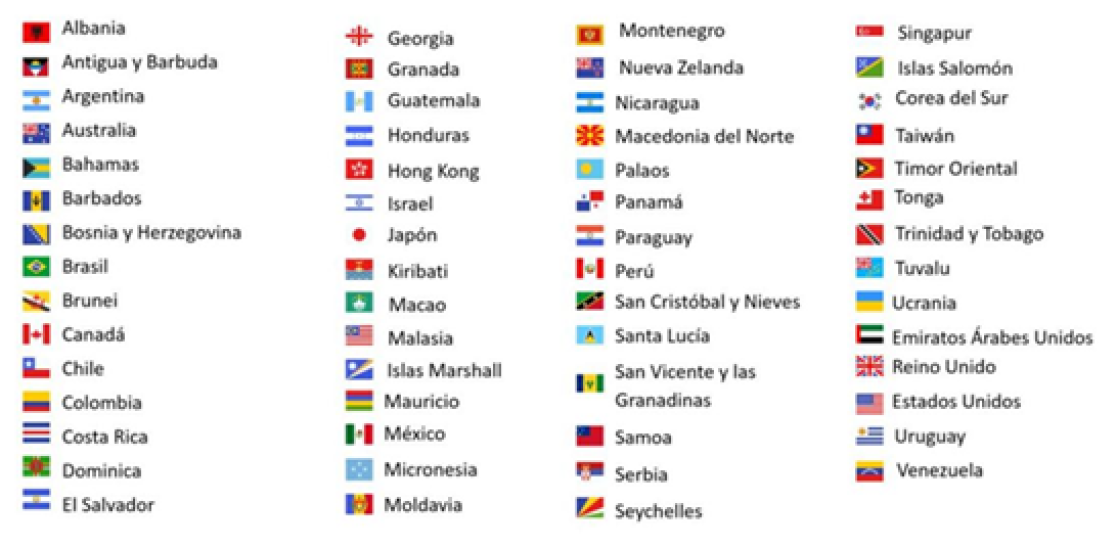Important notice
- The European Travel Information and Authorisation System (ETIAS) is currently not in operation and no applications for travel authorisations are collected at this point.
- Applicants will be able to apply via an official website and/or app for mobile devices prior to the start of operation of ETIAS and will have to pay a fee of €7.
- The date from which travellers will be able to apply will be published on this web site.

How ETIAS functions
ETIAS will be a largely automated IT system created to identify security, irregular migration or high epidemic risks posed by visa-exempt visitors travelling to the Schengen States, whilst at the same time facilitate crossing borders for the vast majority of travellers who do not pose such risks. Non-EU nationals who do not need a visa to travel to the Schengen area will have to apply for a travel authorisation through the ETIAS system prior to their trip. The information gathered via ETIAS will allow, in full respect of fundamental rights and data protection principles, for advance verification of potential security, irregular migration of high epidemic risks.
After filling in an online application form, the system will conduct checks against EU information systems for borders and security and, in the vast majority of cases, issue a travel authorisation within minutes. In limited cases, where further checks on the traveller are needed, the issuing of the travel authorisation could take up to 30 days. The ETIAS travel authorisation will be a mandatory pre-condition for entry to the Schengen States. It will be checked together with the travel documents by the border guards when crossing the EU border. This prior verification of visa exempt non-EU citizens will facilitate border checks; avoid bureaucracy and delays for travellers when presenting themselves at the borders; ensure a coordinated and harmonised risk assessment of third-country nationals; and substantially reduce the number of refusals of entry at border crossing points.
Thanks to ETIAS authorities will receive vital information necessary to assess potential risks with individuals travelling to the EU and, if required, a travel authorisation could be denied. Schengen participating States will be able to manage their external borders more effectively and improve internal security. Travellers will have early indication of their admissibility to the Schengen States, making legal travel across Schengen borders easier.
The European Agency for the operational management of large-scale IT systems in the area of freedom, security and justice (eu-LISA) is responsible for developing the system. ETIAS will start being operational in the first half of 2025. The ETIAS Regulation provides for transitional measures to ensure a smooth roll out of the system.
ETIAS is among the measures undertaken as part of the Security Union. It will also help to achieve the objectives of the European Agenda on Security and the European Agenda on Migration in particular regarding border management and preventing cross-border crime and terrorism.
The European Commission first introduced the idea of a ETIAS in April 2016 in the Communication "Stronger and Smarter Information Systems for Borders and Security" and adopted the proposal on 16 November 2016. After negotiations with the European Parliament and the Council the ETIAS Regulation (EU) 2018/1240 was adopted on 12 September 2018 and entered into force on 9 October 2018.
More information
Press releases.
- Press release/statement made at the time of Commission’s ETIAS proposal
- Press release/statement made at the time of agreement on the ETIAS proposal
- ETIAS factsheet
- Memo (PDF) : Questions and answers on ETIAS
- Feasibility study on ETIAS
Share this page
New requirements for Americans traveling to Europe postponed until 2025
Visitors who now travel visa-free will need to get approval prior to departure.
Americans eyed upcoming travel to European destinations slightly differently due to news of a requirement that was set to start in 2024 for U.S. passport holders. But now, EU officials have postponed the European Travel Information and Authorisation System ( ETIAS ) launch until spring of 2025.
SchengenVisaInfo.com, a website dedicated to the world's largest visa-free zone where 27 European countries abolished their internal borders known as the Schengen Area, first reported that an EU official confirmed ETIAS won't go live until May 2025, "due to continued delays with the introduction of the related Entry-Exit System (EES), which needs to be operational before ETIAS can be implemented."
An official for the European Union did not immediately respond to ABC News' request for comment.
What to know about ETIAS for US travelers
If you previously traveled to Europe without a visa, you will now need to apply for authorization through the ETIAS , before visiting.

Today, American travelers have visa-free access to 184 global destinations, according to the Henley Passport Index . And while the U.S. passport is currently ranked eighth-most powerful passport to own, that could be set to shift when the European Union adds its new documentation requirements for U.S. visitors.
The application form, which will be available on the official ETIAS website as well as a mobile application, has a fee of 7 euros or $7.79 U.S. dollars. All communication is done by email.
Once you are approved for travel, the authorization entitles visitors to stay in European countries that require ETIAS for up to 90 days within any 180-day period and travelers must be in possession of a valid ETIAS during their entire stay.
MORE: New warning issued for rebooking air travel after delays, cancellations
According to ETIAS, most applications should be processed within minutes, but in case an application takes longer, decisions will be sent within four days or up to 14 days if the applicant is asked to provide additional documentation.
The European Union encourages travelers to apply for an ETIAS authorization "well in advance of your planned journey."
Confirmation of application submission will be sent on email with a unique number that is needed for future reference.

Upon receiving ETIAS travel authorization, travelers are to ensure that their name, passport number and other information is correct because any mistake will prevent them from crossing the border.
If an application is refused, the email will include the reasons for the decision along with information about how to appeal.
ETIAS travel authorization is valid for three years, according to the EU, or until the travel document you used in your application expires, whichever comes first.
MORE: European heat wave breaking records with little relief in sight
The ETIAS authorization is linked to a person's travel document -- such as a U.S. passport -- and both documents will be needed to board a flight, bus or ship to enter any of the European countries that require ETIAS.
Similar to international border requirements with a passport, the ETIAS authorization doesn't guarantee automatic right of entry. "Border guards will verify that you meet the entry conditions" and anyone who does not meet the conditions "will be refused entry," according to the EU.
Click here to learn more about the process from the European Union.
An earlier version of this story was originally published on July 21, 2023.
Related Topics
Trending reader picks.

Biden's weakness displayed at debate: ANALYSIS
- Jun 27, 11:34 PM

Biden addresses poor debate performance
- Jun 28, 2:09 PM

5 takeaways from Biden-Trump presidential debate
- Jun 27, 11:56 PM

Fact checking the Biden-Trump presidential debate
- Jun 28, 1:06 AM

Parents at beach with kids die in rip current
- Jun 21, 8:38 AM
ABC News Live
24/7 coverage of breaking news and live events
- About ETIAS
- ETIAS Fundamental Rights Guidance Board
- ETIAS Central Unit
Since mid-2025, people from more than 60 visa-free countries will need to get a travel authorisation before coming to Europe for a brief stay. The authorisation will be processed through the European Travel Information and Authorisation System (ETIAS).
ETIAS will further strengthen Europe’s internal security by carrying pre-travel screening of visa-free travellers to determine whether they pose a security, illegal immigration, or public health risk.
The entire ETIAS ecosystem is complex and consists of the ETIAS Central Unit hosted by Frontex, ETIAS National Units located in 30 European countries, and the large-scale information system developed and maintained by eu-LISA.
How it will work
Before travelling
Citizens of over 60 visa-free countries will need to apply for an ETIAS travel authorisation before heading to any of the 30 European countries shown below.
The ETIAS system will check the information provided by the applicant with data already stored in other EU systems such as the Schengen Information System (SIS), Visa Information System (VIS) and Entry/Exit System (EES). If the application raises any concerns, it will be reviewed by the ETIAS Central Unit and sent to the relevant ETIAS National Unit for final decision.
It is expected that most applications (about 97%) will be approved automatically within minutes. The remaining 3% will be reviewed manually by the ETIAS Central Unit and the National Units.
Travellers who do not have a valid travel authorisation will be refused boarding by the carrier (for example, an airline, bus or ferry company).
At the border
When a visa-free traveller arrives at a border of one of the 30 European countries requiring ETIAS, border guards will scan their travel document data electronically and register them in the EES, triggering a query to ETIAS. If the traveller has a valid travel authorisation, they will be able to cross the border if all other entry conditions are also fulfilled.
More information about what ETIAS means for travellers from visa-free countries can be found on the official ETIAS website .
The role of Frontex in ETIAS
Frontex plays an important role in establishing and managing ETIAS by hosting the ETIAS Central Unit, which will be available 24 hours a day, 7 days a week to handle ETIAS applications and help travellers and carriers.
The ETIAS Central Unit is also responsible for identifying risks, risk indicators and screening rules. These will be used to assess travellers in terms of illegal immigration, security and high epidemic risks. The Unit’s responsibilities also include managing the content of the official ETIAS website, as well as ensuring that the information stored in the system is accurate and up to date.
Fundamental rights and ETIAS
The protection of fundamental rights is at the core of all ETIAS operations.
The ETIAS Fundamental Rights Guidance Board has been set up to assess the impact of processing applications and the screening rules on fundamental rights.
The Guidance Board is composed of representatives of the Frontex Fundamental Rights Office, the Consultative Forum on Fundamental Rights of Frontex, the European Data Protection Supervisor, the European Data Protection Board, and the European Union Agency for Fundamental Rights.
As an independent advisory body, the Fundamental Rights Guidance Board will regularly carry out evaluations and make recommendations to the ETIAS Screening Board regarding its work, particularly regarding privacy, data protection and non-discrimination. The ETIAS Central Unit will consult the opinion of the ETIAS Screening Board to ensure that risk screening is carried out in full respect for fundamental rights.

Information on ETIAS (European Travel Information and Authorisation System)
It is expected that ETIAS will only be implemented in mid-2025.

Beware of scammers
There is only one official ETIAS website: europa.eu/etias . The application form will be made available on this website once the system is launched, which is expected to be in mid-2025.
There are tens of websites claiming to be the official ETIAS application sites: they use the official EU logo, some even collect travellers’ personal data. While it will be legal for the commercial intermediaries to apply on your behalf once the system enters into force, make sure you use one that you trust: some may steal your personal data, passport number and credit card. They may also charge an additional fee for their services. Remember: ETIAS will only cost EUR 7 if you use the ETIAS official website to apply.
All official websites of the European Union can be recognised by the europa.eu domain.
When will ETIAS enter into force?
The system is not yet operational. It is expected to be launched in mid-2025 .
ETIAS in a nutshell
ETIAS travel authorisation is an entry requirement for visa-exempt nationals travelling to any of these 30 European countries . It is linked to a traveller’s passport. It is valid for up to three years or until the passport expires, whichever comes first. If you get a new passport, you need to get a new ETIAS travel authorisation.
With a valid ETIAS travel authorisation, you can enter the territory of these European countries as often as you want for short-term stays - normally for up to 90 days in any 180-day period. However, it does not guarantee entry. When you arrive, a border guard will ask to see your passport and other documents and verify that you meet the entry conditions.
Who needs an ETIAS travel authorisation?
Nationals of any of these visa-exempt EN ••• countries and territories need to apply for an ETIAS travel authorisation.

Applying for an ETIAS travel authorisation
Once available, you can fill out the application form using either this official ETIAS website or the ETIAS mobile application. Applying for the ETIAS travel authorisation will cost approximately EUR 7, though some travellers are exempt from paying this fee. Read more about what you need to apply and payment exemptions .
Processing your ETIAS application
Most applications are processed within minutes.
It is possible however that your application may take longer to process. If so, you will receive a decision within four days. Please note that this period could be extended by up to 14 days if you are requested to provide additional information or documentation, or up to 30 days if you are invited to an interview. This is why you should apply for an ETIAS travel authorisation will in advance of your planned journey.
Once you have applied
You will receive an email conforming the submission of your application which will include your unique ETIAS application number: make sure you keep this number for future reference.
Once your application has been processed, you will receive another email informing you about its outcome.
When you get your ETIAS travel authorisation, please make sure your name, passport number and other information is correct: if there is any mistake, you will not be allowed to cross the border. More information about what to do if you made a mistake in your application can be found here .
If your application is refused , the email will provide the reasons for this decision. It will also include information about how to appeal , details of the competent authority, as well as the relevant time limit to appeal.
Validity period of your ETIAS
Your ETIAS travel authorisation is valid for three years or until the travel document you used in your application expires – whichever comes first.
It is for short-term stays: a valid ETIAS travel authorisation entitles you to stay in the European countries requiring ETIAS for up to 90 days within any 180-day period.
You must be in possession of a valid ETIAS travel authorisation during your entire stay. You can leave and come back at any time, as long as you respect this time limit.
On arrival at the border
As your ETIAS travel authorisation is linked to your travel document, make sure to carry the same document which you used in your ETIAS application. Otherwise, you will not be allowed to board your flight, bus or ship, or to enter any of the European countries requiring ETIAS.
Having a valid ETIAS travel authorisation does not guarantee an automatic right of entry. When you arrive at the border, border guards will verify that you meet the entry conditions . Those travellers who do not meet the entry conditions will be refused entry.
More information about what to expect when crossing EU borders is available here .
Your ETIAS check-list
- Apply for an ETIAS travel authorisation will in advance – before you buy your ticket or book your accommodation.
- Make sure your passport details correspond to those in your ETIAS authorisation – you will be refused boarding and entry at the border if they do not match.
- Make sure your ETIAS travel authorisation is still valid.
- Check how long you can stay in the European countries requiring ETAIS.
- Make sure your passport is valid for three months after your intended departure from the European countries requiring ETIAS – you will be refused entry at the border if it is not ( exceptions apply ).
For more information, consult the official ETIAS website.
7 things you need to know about ETIAS
- ETIAS is a new travel requirement:
If you come from one of the above-listed countries and territories, as of 2024, you will need to get an ETIAS travel authorisation to any of the 30 European countries.
- To apply for an ETIAS you will need:
- A passport valid for more than 3 months
- An e-mail address
- To fill out an online form
- To pay a EUR 7 fee
- ETIAS is for short-term visits
With a valid ETIAS travel authorisation, you will be able to stay in any of the 30 European countries for 90 days in any 180-day period.
- Your travel authorisation will be valid for three years
Your travel authorisation will be valid for three years or until the passport you used in the application expires, whichever comes first. You can use it for multiple entries.
- ETIAS is not a visa
You will apply for ETIAS online, you do not need to go to a Consulate, your biometric data will not be collected, and it will be much faster and cheaper than getting the Schengen visa.
- Europe is not the first to introduce travel authorisations for visa-free nationals
Similar travel authorisations are required by the United States, Canada, and Australia.
- The system is not yet operational
The system is not yet operational and no applications are collected at this point. ETIAS is expected to be launched in mid-2025.
Be careful whom you provide your personal information to and how much money they charge you for their services. The protection of your personal data cannot be guaranteed if you use another website to submit your application.
MORE STORIES

'Women at the European External Action Service' and the Belgian Foreign Ministry’s 'Women at Work' join forces!

International Day in Support of Victims of Torture 2024

Inauguration of the exhibition “75 Women in 75 Years of Council of Europe History” during the Parliamentary Assembly’s Summer Session

The EU updates its Guidelines on Children and Armed Conflict

New package of EU sanctions on Russia

U.S. Citizens Will Need to Register and Pay a Fee to Travel to Europe—Here’s When and What to Know
The launch of europe’s new etias travel authorization program has been delayed yet again. here’s what travelers need to know for when it finally goes into effect..
- Copy Link copied

France is among the more than two dozen Schengen countries in Europe that will (eventually) have new entry rules.
Photo by Chan Lee/Unsplash
Europe is the most visited region in the world and has always been a very popular destination for U.S. travelers. After pandemic travel restrictions were dropped across Europe in 2022 and now that U.S. citizens are plotting future journeys to the continent once again, they should be aware that the rules for entry into the European Schengen Zone will soon change.
Initially meant to come into effect on January 1, 2021 and then delayed (again and again) until 2024, the European Travel Information and Authorization System ( ETIAS ) is now slated to launch sometime in 2025 (more on the actual launch date below). At that point, all U.S. citizens who want to travel to the 27 member countries of Europe’s Schengen Zone will need to register with ETIAS or risk being turned away at the border.
Here’s everything you need to know about the new ETIAS process.
Why are the requirements for entering Europe changing?
The European Union decided to implement this new travel authorization program to protect and strengthen its borders amid mounting terror threats in Europe. By requiring visitors to register, the hope is that the EU will be able to identify any possible threats or risks associated with travelers coming into the participating countries before they arrive.
Which European nations will require ETIAS authorization to visit?
The new travel authorization applies to those entering any member country of Europe’s Schengen Zone. Currently, that includes 23 countries that are also members of the European Union, four non-EU countries, plus three European micro-states. That means that you’ll need to register to enter:
- Czech Republic
- Liechtenstein
- Netherlands
- Switzerland
- Vatican City
While Romania and Bulgaria aren’t currently Schengen countries, they are in the process of joining and will be subject to the same requirements once they do.
However, there are still many European nations that aren’t part of the Schengen Zone, mostly in Eastern Europe. That means you’ll be able to travel to Albania, Andorra, Armenia, Azerbaijan, Belarus, Bosnia and Herzegovina, Cyprus, Georgia, Kosovo, Macedonia, Moldova, Montenegro, Serbia, Türkiye, and Ukraine without an ETIAS registration.
Who will need to obtain ETIAS authorization?
American citizens, as well as travelers from 60 other countries, will require an ETIAS visa waiver to travel to any of the Schengen-zone countries for short stays once the ETIAS program goes into effect. The list of ETIAS-eligible countries includes Canada, Mexico, Australia, and many more. All travelers, regardless of their age, will need their own ETIAS approval in order to travel to Europe’s Schengen Zone countries.
How will travelers apply for ETIAS?
Once the ETIAS application is available online, it should only take about 10 minutes to fill out, according to ETIAS.com, the landing page for news and information regarding the new travel authorization process. To apply, you’ll need a valid passport , an email address, and a debit or credit card to pay the nonrefundable 7-euro application fee, which applies to individuals between the ages of 18 and 70. Those under the age of 18 or over 70 still need to have an ETIAS but will not be charged.
How much will it cost to enter Europe?
To obtain an ETIAS registration, there will be a required, nonrefundable application fee of 7 euros (US$7.43, based on conversion rates at time of publication). Only travelers who are younger than 18 years old or older than 70 years old will be exempt from the fee (though the will still need to have ETIAS approval). There are no other fees associated with the program.
How long will the authorization process take?
After you fill out your application online with the personal information on your passport and answer a series of security and health-related questions, your ETIAS application will be processed immediately, and you will receive an email confirming that your ETIAS has been approved within 96 hours.
“A small percentage of applications may take up to four weeks to process if additional documentation is required from the applicant. If your ETIAS has not yet been approved and you do not have any other travel authorization, you will not be able to enter a country within the European Union,” according to the ETIAS website .
Will you have to reapply for each trip to Europe?
No, you will not need to reapply after each trip to Europe. After you apply for the first time, your ETIAS authorization will be valid for three years—or until your passport expires , whichever comes first. Because the ETIAS is valid for short-term stays of up to 90 days for both leisure and business travelers, you’ll be able to re-enter Europe multiple times within that three-year period without renewing it, as long as your stay doesn’t exceed 90 days within a 180-day period. Those who want to study or work in Europe will need to apply for a proper work or study visa.
Does this mean I will need a visa to travel to Europe?
ETIAS is not a visa; it’s a travel authorization requirement for visa-free visitors , similar to the U.S. Electronic System for Travel Authorization (ESTA) .
The new entry requirement “is more accurately referred to as a visa-waiver. The ETIAS, like the ESTA, is a travel authorization for travelers not requiring a visa to visit Europe. Under the ETIAS, these visitors will undergo additional security checks prior to being permitted to enter the EU. The ETIAS will be mandatory for citizens of such countries as the United States, Australia, New Zealand and Canada,” states ETIAS.com .
In other words, ETIAS will only pre-screen travelers who do not need a Schengen visa.
“An ETIAS travel authorization does not reintroduce visa-like obligations,” according to a fact sheet provided by the European Commission . “There is no need to go to a consulate to make an application, no biometric data is collected and significantly less information is gathered than during a visa application procedure.”
Why was the launch of ETIAS delayed?
Initially meant to come into effect on January 1, 2021, the ETIAS was first delayed until January 1, 2023, and then again (a few more times) until 2024. It is now slated to enter into operation in 2025, due to delays in the anticipated adoption of the ETIAS regulation plus the fact that ETIAS is being developed closely with the Entry/Exit System (EES). The EES was scheduled to launch in May 2023, but it has been pushed back until 2024. The EES is an electronic system that will keep track of visitors as they cross borders, and its installation is a precondition for ETIAS to enter into operation.
When exactly will ETIAS go into effect?
In October 2023, the European Commission presented an updated timeline for the launch of Europe’s new tech-driven Entry/Exit System (EES), which will keep track of visitors as they cross borders, and for Europe’s ETIAS travel authorization program. The new ETIAS travel entry requirement is now scheduled to launch in mid-2025 , following the establishment of Europe’s new tech-driven EES that is slated to go into effect in the fall of 2024, according to the Commission.
Once ETIAS goes into effect in 2025, a transitional period of six months will follow. During that time frame, the countries requiring the travel authorization will have to inform travelers of the new regulations. They will still be allowed to cross borders during that six-month period without the ETIAS. The six-month transitional period will be followed by a grace period, the length of which has not yet been determined. During the grace period, the ETIAS requirement will apply unless it’s a traveler’s first time entering Europe since the end of the transitional period.
This article was originally published in 2019. It was most recently updated on November 2, 2023, to include current information.

ETIAS: all you need to know about the essential task added to your European travel checklist

Oct 27, 2023 • 4 min read

An ETIAS will be required for entry to Italy and 29 other European countries © Marco Secchi / Getty Images
After multiple delays, EU officials said they'll finally introduce the ETIAS regulation in 2025. Initially planned for implementation in late 2023, the system will require forward planning from US travelers and others when visiting Europe.
You've booked your tickets, made reservations at your favorite restaurants, but hold on, there will soon be one more essential task to add to your checklist when planning your European vacation.
Beginning in spring 2025, visa-exempt foreigners visiting 30 European countries will have to fill out an application for the European Travel Information and Authorization System (ETIAS).
The new screening process, which includes an online registration and small application fee, is essentially a background check aimed at protecting the borders of countries within Europe’s Schengen Zone . An ESTIAS is not a visa, but similar to ESTA , a visa-waiver program used in the United States since 2008.
The new process also means travelers won't receive passport stamps anymore. Instead, their faces and fingerprints will be scanned and recorded in a new digital registration system starting next autumn. The changes are anticipated to lead to shorter waiting times at entry points and a more streamlined process, according to officials.
The security measure will impact roughly 1.4 billion travelers from over 60 countries including the US.

While applying for an ETIAS might initially seem daunting, it's just a tiny bump on the trip-planning journey. Travelers should be far more concerned about the increasing regularity of heat waves scorching southern Europe in the late spring and summer months and over-tourism plaguing cities from Amsterdam to Venice. Filling out the ETIAS application, on the contrary, should be quick and hassle-free.
Here's everything you need to know.
Who needs to apply for an ETIAS?
Passport holders from around 60 countries – including citizens from the US, Canada, Mexico, and the UK – will require an ETIAS authorization for short-term stays, regardless of age. The EU defines a short-term stay as any visit, or combination of stays, that last up to 90 days within a 180-day period. Without an ETIAS, travelers risk being turned away at the border.
Visit the ETIAS website for a complete list of passport holders and European destinations affected by the change.
How do I apply?
Once the ETIAS application becomes available online, travelers (or authorized third parties , like family members and travel agencies) can fill out the digital form via the ETIAS website or app, which should take roughly 10 minutes.
To apply, you’ll need to provide an approved, up-to-date travel document, like a passport, along with personal information, including your phone number, parents’ first name(s), level of education, current occupation, and details about where you intend to stay. Applicants must also provide details about past criminal convictions and visits to war zones.
How much does the application cost?
For applicants ages 18-70, there will be a non-refundable €7 fee (roughly $8) payable by debit or credit card. Anyone younger than 18 or older than 70 won't be charged the application fee. Family members of EU citizens are also exempt from payment.

When should I apply?
EU officials recommend applying before booking hotel and flight reservations. To be on the safe side, this should be no later than one month before an intended trip.
While most ETIAS applications will be processed within minutes, some decisions may be delivered within four days. That wait time can extend up to 14 days if additional information is required and up to 30 days if you're asked to interview.

Can I apply for an ETIAS without upcoming travel plans?
Yes, though you’ll need to indicate the country where you intend to stay on your application. Once authorized, it’s possible to change plans and travel to any of the 30 countries requiring an ETIAS.
How will I know if I’m approved?
After applying online, ETIAS applicants will receive two emails. The first email will confirm that the application has been successfully submitted. Once the application is processed, you'll receive a second email with an authorization decision.
How long will my ETIAS authorization last?
ETIAS authorization will be valid for three years or until your passport expires, whichever comes first. You can leave and re-enter countries requiring an ETIAS as often as you desire within that window, as long as your travel doesn't exceed the short-term stay limit.
What type of ETIAS documentation will I need to enter the EU?
You don’t need to print out the actual ETIAS confirmation, but it’s imperative to bring the passport linked to your authorization.
Ensure all the details on your passport and ETIAS match before traveling – and that your passport is valid for three months after your departure date – or you’ll be turned away at the border.
What happens if my application gets denied?
You’ll receive a notification explaining why your application was refused, along with follow-up information about appealing the decision.
To avoid a refusal, double-check your work before submitting the application. Even simple typing errors – like the misspelling of a name – can result in rejection. Don’t let a misplaced vowel thwart your grand European adventure.
This article was first published Jul 31, 2023 and updated Oct 27, 2023.
Explore related stories

Jun 21, 2024 • 5 min read
Three words: Cute. Tiny. Airports. Here is our pick of the USA's very best.

Jun 29, 2024 • 8 min read

Jun 29, 2024 • 9 min read

Jun 28, 2024 • 6 min read

Jun 28, 2024 • 5 min read

Jun 28, 2024 • 9 min read

Jun 28, 2024 • 7 min read

- World Politics /
- European Union
The extra step you’ll need to take before flying to Europe next year
The EU has a new travel authorization program, ETIAS, set to roll out in 2024 that will affect travelers across the globe.
by Ellen Ioanes

Travelers to Europe from many countries, including the US,will soon be required to apply for a travel authorization known as ETIAS, or the European Travel Information and Authorization System, to visit destinations like France, Italy, and Spain, as well as 27 other European countries .
For years, US citizens have been able to travel to many European countries for short visits without any prior travel authorization, but that will change when the new policy goes into effect — likely sometime in 2024. The EU has attempted for years to get some manner of travel authorization on the books for travelers from countries where a visa isn’t required to enter EU nations, without success.
The new system is best thought of as a database to track who’s authorized to enter European countries, rather than as a visa. The authorization, once given, is valid for three years and permits short trips — 90 days or fewer at a given time. Longer stays, like for school or work, already require visas.
Though it may seem like a major change for Americans and citizens of other countries that currently have visa-free entry to European countries, the US has its own authorization system, the Electronic System for Travel Authorization, or ESTA . Citizens and eligible residents of certain countries — mostly in Europe, but also including South Korea, Brunei, Chile, and Japan — don’t have to have a visa for shorter visits to the US, but they do need ESTA authorization. Visa holders don’t require ESTA authorization, because obtaining a visa requires much more information from travelers and an interview at a consulate.
Why is ETIAS going into effect?
According to a memo released by the European Commission, “ETIAS will be a largely automated IT system created to identify any security or irregular migratory risks posed by visa-exempt visitors travelling to the Schengen area, whilst at the same time facilitate crossing borders for the vast majority of travellers who do not pose such risks.” The Schengen area is a group of 27 European countries — 23 of the 27 EU countries plus Iceland, Switzerland, Norway, and Liechtenstein — which allow travel between them without internal border controls.
The system has been in the works for several years, according to NPR , and the European Commission introduced the idea in 2016 . The US version, ESTA,went into effect in 2008.
ESTA has a mandate to prevent terrorist crime through its tie to the Visa Waiver Program Improvement and Terrorist Travel Prevention Act of 2015. That legislation barred nationals of North Korea, Iraq, Sudan, and Iran who also held nationality in an ESTA-eligible country from the program; anyone who traveled to those countries, Libya, Somalia, Syria, or Yemen after March 1, 2011, is also ineligible for ESTA, even if they would otherwise meet the eligibility criteria.
ETIAS is also ostensibly a tool to help prevent crime, irregular migration, and public health threats, according to FRONTEX , Europe’s border security force. Irregular migration to Europe from countries including Egypt, Pakistan, Syria, and Tunisia has trended upward in the past two years in particular due to political instability, economic and environmental crisis, and conflict. The most high-profile cases of irregular migration occur via human trafficking operations and small vessels, but other methods of irregular migration, including via plane and land crossings, occur as well.
ETIAS is aimed at reducing or preventing serious crimes, which according to EUROPOL include human trafficking, drug trafficking, and arms smuggling, as well as terrorist crimes. The 2018 European Parliament legislation establishing ETIAS suggests creating a watchlist which “shall consist of data related to persons who are suspected of having committed or taken part in a terrorist offence or other serious criminal offence or persons regarding whom there are factual indications or reasonable grounds, based on an overall assessment of the person, to believe that they will commit a terrorist offence or other serious criminal offence.” Essentially, based on the metrics established under the legislation, a person can be denied authorization if the relevant authorities — EUROPOL and member states — believe that an applicant might commit terrorism or another serious crime.
An official EU memo states that ETIAS applications will be checked against “ EU information systems for borders and security, ” though it doesn’t specify which systems. An EU press release from 2016 identifies “the Visa Information System (VIS), Europol data, the Schengen Information System (SIS), Eurodac and the European Criminal Records Information System (ECRIS)” as databases to be used in the ETIAS verification process.
Though the idea for ETIAS was introduced years ago, getting all the members of the European Parliament to find a system they could agree on was challenging, Dan Hamilton, a senior non-resident fellow for foreign policy at the Brookings Institution, told NPR .
“Another part of it is simply the pace of the way this parliament and European commission works,” he said. “They’re ending their term and pushing through a lot of these directives because parliamentary elections happen next June.”
What does it mean for travelers?
The ETIAS website isn’t yet active, so it’s impossible to know the requirements for the authorization or see the form travelers will have to fill out. However, according to an official memo about the ETIAS program , the only documentation travelers will require is a valid passport that expires no less than three months after your intended travel date. Only travelers between the ages of 18 and 70 need to apply.
As the memo states, the ETIAS authorization isn’t the same as a visa:
An ETIAS travel authorisation does not reintroduce visa-like obligations. There is no need to go to a consulate to make an application, no biometric data is collected and significantly less information is gathered than during a visa application procedure. Whereas, as a general rule, a Schengen visa procedure can take up to 15 days, and can in some cases be extended up to 30 or 60 days, the online ETIAS application only takes a few minutes to fill in.
The application will cost 7 euros — about $7.70 per the typical exchange rate — and will apply to travelers from dozens of different countries , including Singapore, New Zealand, Brazil, Israel, Australia, Japan, and the UK.
Although it’s recommended to apply at least a month in advance of travel, all advisory information from the EU claims that the application and approval process will take just a few minutes, so it’s still possible to make emergency travel work with the new system. “Only in very exceptional cases, could the ETIAS procedure take up to 30 days,” according to the official memo on the system .
The authorization is good for a period of three years — “significantly longer than the validity of a Schengen visa,” as the memo points out, and “will be valid for an unlimited number of entries.”
Although the official memo estimates that 95 percent of applications will be approved, rejected applicants will be told the reason for their rejection — and will be able to appeal or apply again. However, ETIAS approval isn’t a guaranteed entry into a given country; border guards still have the final say.
Most Popular
The supreme court just lit a match and tossed it into dozens of federal agencies, the silver lining to biden’s debate disaster, the supreme court just made a massive power grab it will come to regret, why the supreme court just ruled in favor of over 300 january 6 insurrectionists, hawk tuah girl, explained by straight dudes, today, explained.
Understand the world with a daily explainer plus the most compelling stories of the day.
More in European Union

Why Europe is lurching to the right

Eurovision says it’s “apolitical.” History says otherwise.

How the overturn of Roe v. Wade sparked a new campaign for abortion rights across Europe

How 2,000 elderly Swiss women won a landmark climate case

The dangerous resurgence of Germany’s far right, explained

The French farmers’ protests are more complex than they seem

What, if anything, is AI search good for?

What Kenya’s deadly protests are really about

How the UFC explains the USA Audio

Kevin Costner, the American Western, and the American ego

LBJ and Truman knew when to quit. Will Biden?

How Democrats got here
- Credit cards
- View all credit cards
- Banking guide
- Loans guide
- Insurance guide
- Personal finance
- View all personal finance
- Small business
- Small business guide
- View all taxes
You’re our first priority. Every time.
We believe everyone should be able to make financial decisions with confidence. And while our site doesn’t feature every company or financial product available on the market, we’re proud that the guidance we offer, the information we provide and the tools we create are objective, independent, straightforward — and free.
So how do we make money? Our partners compensate us. This may influence which products we review and write about (and where those products appear on the site), but it in no way affects our recommendations or advice, which are grounded in thousands of hours of research. Our partners cannot pay us to guarantee favorable reviews of their products or services. Here is a list of our partners .
ETIAS: What It Is, How it Works and What Does It Mean for Travel?

Sean Cudahy is a freelance reporter specializing in coverage of airlines, travel, loyalty programs and public policy. A journalist of nine years, Sean most recently served as a general assignment reporter at The Points Guy, following an eight-year run as a local television news reporter. He lives with his wife and their French Bulldog outside Raleigh, North Carolina.

Many or all of the products featured here are from our partners who compensate us. This influences which products we write about and where and how the product appears on a page. However, this does not influence our evaluations. Our opinions are our own. Here is a list of our partners and here's how we make money .
Table of Contents
What is ETIAS?
When is the estimated etias start date, is etias approval required for u.s. citizens, which destinations will require an etias application for entry, what are the etias requirements, how much does etias cost, what happens after you apply for etias, how long does etias approval last, etias, recapped.
One benefit U.S travelers to Europe have long enjoyed is a visa waiver, as many countries have allowed Americans to visit for of up to 90 days for tourism without a visa.
However, starting in 2025, U.S. travelers will have to go through a few more steps to visit much of Europe.
More than two dozen countries will soon require visitors from the U.S., United Kingdom and many other visa-exempt countries to apply for a pre-travel authorization through the European Travel Information and Authorisation System, commonly known as “ETIAS.”
Here’s what you should know about ETIAS.
ETIAS is a travel security program set to launch in 2025 for travelers from visa-exempt countries to enter the Schengen Area. Affected travelers include U.S. citizens.
The program is being implemented as a method of protecting the region’s borders. It requires an online application and fee, and approval is needed for all short-term stays including vacations and business trips.
Though not a visa, it is an additional clearance step for visitors to the region. An ETIAS approval allows you to visit the included countries for up to 90 days within a 180-day period.
» Learn more: Visa vs. passport: What’s the difference?
According to the European Commission’s latest update in October 2023, ETIAS is set to launch at some point in the first half of 2025, though an exact date has yet to be announced. The program has already been delayed multiple times in the past, so an official start date is still to be determined.
ETIAS is required for travelers from visa waiver countries — those whose citizens can enter the Schengen area without needing to apply for a visa — which includes the U.S.
Along with ETIAS for U.S. citizens, those from 59 other countries will also need to apply to visit Europe. These countries include, but aren’t limited to, Australia, Brazil, Canada, Colombia, Israel, Japan, Mexico, New Zealand, Singapore, Taiwan and the United Kingdom.
A full list of countries that will require ETIAS approval to visit Europe is located on the official ETIAS webpage .
» Learn more: How to save money on international flights
If you’re headed to one of the countries listed below, you’ll need to fill out an ETIAS application prior to traveling.
Czech Republic.
Liechtenstein.
Luxembourg.
Netherlands.
Switzerland.
Travelers to the United Kingdom and Ireland will not need authorization through ETIAS to enter.
Once the program has launched, the ETIAS application can be completed online. You’ll need to fill out an application on the program’s official website or mobile app.
» Learn more: How to choose a credit card for Europe travel
You’ll be asked to provide personal information like your name, date and place of birth, nationality, address, parents’ names, email address, phone number and passport number.
The application may also ask questions about your level of education or occupation as well as details about your trip and what you intend to do while traveling. Finally, you’ll need to disclose any past criminal convictions and/or travels to war or conflict zones.
The application fee for ETIAS is expected to be 7 euros, which is about $8.
Applicants under the age of 18 or over the age of 70 will be exempt from the fee, as will family members of EU citizens.
» Learn more: The cheapest business class awards to Europe
Once you pay the fee and submit your application, you’ll get an email confirming the submission. This email will include your unique ETIAS application number — keep this handy.
Once you are given your ETIAS application number, verify that all information you submitted is correct — if it’s not, you could run into problems at the border.
Soon after, you’ll likely receive another email informing your approval status. Most decisions come within minutes of submitting your application.
Even after you receive an approval, you’ll still have to go through passport control upon arrival in your destination country and meet all other entry requirements. You’ll also need to carry the same passport and/or travel document you used for your ETIAS application.
What if I am not approved?
There is a chance you’ll be asked to submit additional documentation or even attend an interview rather than approved. In that case, it could take up to 30 days to receive a decision, so it’s best to submit your application well in advance of your trip.
Once your ETIAS application is approved, it’s valid for three years or until your passport’s expiration date, whichever comes first. If you get a new passport, you’ll need to re-apply with your new passport information.
» Learn more: How to stretch your dollar on a European vacation
Starting in 2025, U.S. travelers will need to apply online and pay a fee to visit much of Europe through a new program called ETIAS.
Once the program begins, you’ll be able to submit an application online. If it’s approved, it will be valid for three years or until your passport expires. You’ll be able to use the approval to visit any ETIAS-eligible country for up to 90 days within a 180-day period.
How to maximize your rewards
You want a travel credit card that prioritizes what’s important to you. Here are some of the best travel credit cards of 2024 :
Flexibility, point transfers and a large bonus: Chase Sapphire Preferred® Card
No annual fee: Bank of America® Travel Rewards credit card
Flat-rate travel rewards: Capital One Venture Rewards Credit Card
Bonus travel rewards and high-end perks: Chase Sapphire Reserve®
Luxury perks: The Platinum Card® from American Express
Business travelers: Ink Business Preferred® Credit Card
On a similar note...

New requirements for Americans traveling to Europe postponed until 2025

Americans eyed upcoming travel to European destinations slightly differently due to news of a requirement that was set to start in 2024 for U.S. passport holders. But now, EU officials have postponed the European Travel Information and Authorisation System ( ETIAS ) launch until spring of 2025.
SchengenVisaInfo.com, a website dedicated to the world's largest visa-free zone where 27 European countries abolished their internal borders known as the Schengen Area, first reported that an EU official confirmed ETIAS won't go live until May 2025, "due to continued delays with the introduction of the related Entry-Exit System (EES), which needs to be operational before ETIAS can be implemented."
An official for the European Union did not immediately respond to ABC News' request for comment.
What to know about ETIAS for US travelers
If you previously traveled to Europe without a visa, you will now need to apply for authorization through the ETIAS , before visiting.

Today, American travelers have visa-free access to 184 global destinations, according to the Henley Passport Index . And while the U.S. passport is currently ranked eighth-most powerful passport to own, that could be set to shift when the European Union adds its new documentation requirements for U.S. visitors.
The application form, which will be available on the official ETIAS website as well as a mobile application, has a fee of 7 euros or $7.79 U.S. dollars. All communication is done by email.
Once you are approved for travel, the authorization entitles visitors to stay in European countries that require ETIAS for up to 90 days within any 180-day period and travelers must be in possession of a valid ETIAS during their entire stay.
Related Articles
MORE: New warning issued for rebooking air travel after delays, cancellations
According to ETIAS, most applications should be processed within minutes, but in case an application takes longer, decisions will be sent within four days or up to 14 days if the applicant is asked to provide additional documentation.
The European Union encourages travelers to apply for an ETIAS authorization "well in advance of your planned journey."
Confirmation of application submission will be sent on email with a unique number that is needed for future reference.

Upon receiving ETIAS travel authorization, travelers are to ensure that their name, passport number and other information is correct because any mistake will prevent them from crossing the border.
If an application is refused, the email will include the reasons for the decision along with information about how to appeal.
ETIAS travel authorization is valid for three years, according to the EU, or until the travel document you used in your application expires, whichever comes first.
MORE: European heat wave breaking records with little relief in sight
The ETIAS authorization is linked to a person's travel document -- such as a U.S. passport -- and both documents will be needed to board a flight, bus or ship to enter any of the European countries that require ETIAS.
Similar to international border requirements with a passport, the ETIAS authorization doesn't guarantee automatic right of entry. "Border guards will verify that you meet the entry conditions" and anyone who does not meet the conditions "will be refused entry," according to the EU.
Click here to learn more about the process from the European Union.
An earlier version of this story was originally published on July 21, 2023.
Related Topics
Up next in travel—.

The summer of gig-tripping: How the travel trend has taken off with Taylor Swift fans

Look at these adorable pandas arrive to the US from China

New travel deals for Amazon Prime members on cruises, rental cars, flights and more

Entry/Exit System (EES)
- Entry/Exit system is currently not in operation.

Share this page

IMAGES
VIDEO
COMMENTS
What is ETIAS. The rules of travel to Europe have changed. Starting in the first half of 2025, some 1.4 billion people from over 60 visa-exempt countries are required to have a travel authorisation to enter most European countries.
In limited cases, where further checks on the traveller are needed, the issuing of the travel authorisation could take up to 30 days. The ETIAS travel authorisation will be a mandatory pre-condition for entry to the Schengen States. It will be checked together with the travel documents by the border guards when crossing the EU border.
New requirements to travel to Europe. Entry/Exit System (EES) is the system for registering non-EU nationals travelling for a short stay in 29 European countries (starting in the second half of 2024). ETIAS is the Travel authorisation for visa-exempt travellers to enter 30 European countries (starting in the first half of 2025).
October 2, 2023, 6:29 AM. Americans eyed upcoming travel to European destinations slightly differently due to news of a requirement that was set to start in 2024 for U.S. passport holders. But now ...
ETIAS travel authorisation is an entry requirement for visa-exempt nationals travelling to any of these 30 European countries. It is linked to a traveller's passport. It is valid for up to three years or until the passport expires, whichever comes first. If you get a new passport, you need to get a new ETIAS travel authorisation.
ETIAS. Since mid-2025, people from more than 60 visa-free countries will need to get a travel authorisation before coming to Europe for a brief stay. The authorisation will be processed through the European Travel Information and Authorisation System (ETIAS). ETIAS will further strengthen Europe's internal security by carrying pre-travel ...
ETIAS travel authorisation is an entry requirement for visa-exempt nationals travelling to any of these 30 European countries. It is linked to a traveller's passport. It is valid for up to three years or until the passport expires, whichever comes first. If you get a new passport, you need to get a new ETIAS travel authorisation.
ETIAS stands for the European Travel Information and Authorization System. It is a visa waiver pre-screening program for visitors who don't need a Schengen visa, intending to travel to the European Union. It is created by the EU in order to protect and strengthen its borders and is very similar to the United States Electronic System for ...
In other words, ETIAS will only pre-screen travelers who do not need a Schengen visa. "An ETIAS travel authorization does not reintroduce visa-like obligations," according to a fact sheet provided by the European Commission.. "There is no need to go to a consulate to make an application, no biometric data is collected and significantly less information is gathered than during a visa ...
Passport holders from around 60 countries - including citizens from the US, Canada, Mexico, and the UK - will require an ETIAS authorization for short-term stays, regardless of age. The EU defines a short-term stay as any visit, or combination of stays, that last up to 90 days within a 180-day period. Without an ETIAS, travelers risk being ...
And it's nothing to worry about. Basically, all it means is that travelers from visa-exempt countries, which includes the United States, only need a travel authorization to enter 30 European ...
The EU has a new travel authorization program, ETIAS, set to roll out in 2024 that will affect travelers across the globe. by Ellen Ioanes. Jul 30, 2023, 12:54 PM PDT. As soon as next year ...
You need a travel document that is recognised by the European countries requiring ETIAS. Please check here or here to find out if your travel document is recognised by the countries you intend to travel to.. Your travel document should be valid for more than three months after the intended date of departure from the territory of the European countries requiring ETIAS and should not be older ...
ETIAS stands for European Travel Information and Authorization System. It is a completely electronic system that allows and tracks visitors from countries who do not need a visa to enter the Schengen Zone. It resembles the U.S. Electronic System for Travel Authorization (ESTA), which serves a similar purpose. Also, there should be no confusion ...
The European Union will issue new pre-travel authorizations, which you will want to remember when preparing for your cruise in 2024 or later. Starting in 2024, the European Commission will roll out an electronic travel authorization system called ETIAS required by all visitors from countries that are currently not part of the EU.
Dimitris Avramopoulos at the press conference in Brussels for the proposal for ETIAS. The European Travel Information and Authorisation System (ETIAS) is a planned electronic authorisation system of the European Union for visa-exempt visitors travelling to the Schengen Area (including EFTA countries), as well as Cyprus.. According to the European Commission, it is implemented "for the ...
ETIAS is a travel security program set to launch in 2025 for travelers from visa-exempt countries to enter the Schengen Area. Affected travelers include U.S. citizens. The program is being ...
Choose the travel insurance coverage area (Schengen only or Extended Europe). Fill in the dates of your travel to Europe. Get the price. Pay online. Get your travel insurance certificate via email. Getting your travel visa insurance from Europ Assistance will allow you to enjoy your trip from the U.S.A to Europe with peace of mind.
CNN —. US citizens visiting parts of Europe will need authorization from the European Union come 2021. The EU announced last year it was creating a European Travel Information and Authorization ...
UK nationals are required to have a valid ETIAS travel authorisation if they travel to any of the European countries requiring ETIAS for a short-term stay (90 days in any 180-day period). UK nationals who wish to stay longer must meet the entry requirements in accordance with national or EU migration law, such as holding a visa or residence permit.
Getting Ready for Europe's Travel Authorization Scheme. Over the span of many years, the European Union (EU) has been preparing to introduce two new border management IT systems - the Entry/Exit Systems (EES) and the European Travel Information and Authorisation System (ETIAS). These systems are designed to streamline the electronic ...
Travel documents. To apply, you will need a valid travel document to which a visa may be affixed. Your travel document should not expire in less than three months and it should not be older than 10 years. If your document expires sooner, check here to know how it affects your travel. A travel document which does not comply with international ...
Visitors to Europe from 60 visa-exempt territories, including Hong Kong, will need travel authorisation from as early as the start of next year, the EU has said. The bloc added the introduction of ...
China has extended visa-free travel to Poland, Australia and New Zealand until the end of 2025. Since the start of 2024, the scheme has been announced in stages, with 11 other European countries ...
October 02, 2023, 6:29 am. Americans eyed upcoming travel to European destinations slightly differently due to news of a requirement that was set to start in 2024 for U.S. passport holders. But now, EU officials have postponed the European Travel Information and Authorisation System ( ETIAS) launch until spring of 2025.
European Entry/Exit System will register non-EU nationals each time they are visiting European countries. Travelers will be able to check the number of days they are allowed to stay in Europe. It will make passport control faster and will replace the need for passports to be stamped.